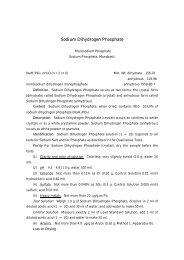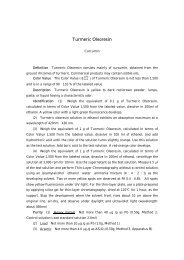Thiamine Hydrochloride
Thiamine Hydrochloride
Thiamine Hydrochloride
- No tags were found...
You also want an ePaper? Increase the reach of your titles
YUMPU automatically turns print PDFs into web optimized ePapers that Google loves.
<strong>Thiamine</strong> <strong>Hydrochloride</strong><br />
Vitamin B1 <strong>Hydrochloride</strong><br />
C12H17ClN4OSHCl Mol. Wt. 337.27<br />
3-(4-amino-2-methylpyridine-5-ylmethyl)-5-(2-hydroxyethyl)-4-methylthiazolium<br />
chloride monohydrochloride 67-03-8<br />
Content <strong>Thiamine</strong> <strong>Hydrochloride</strong>, calculated on the anhydrous basis, contains<br />
98.0102.0% of thiamine hydrochloride (C12H17ClN4OSHCl).<br />
Description <strong>Thiamine</strong> <strong>Hydrochloride</strong> occurs as white to yellowish-white, fine<br />
crystals or crystalline powder. It is odorless or has a slight, characteristic odor.<br />
Identification (1) To 1 ml of <strong>Thiamine</strong> <strong>Hydrochloride</strong> solution (1 500), add 1<br />
ml of lead acetate TS and 1 ml of sodium hydroxide solution (1 10). The color of the<br />
solution changes to yellow. Warm on a water bath. It changes to brown. Then allow to<br />
stand. A black-brown precipitate is formed.<br />
(2) To 5 ml of <strong>Thiamine</strong> <strong>Hydrochloride</strong> solution (1 500), add 2.5 ml of sodium<br />
hydroxide solution (1 25) and 0.5 ml of freshly prepared potassium ferricyanide<br />
solution (1 10), then add 5 ml of isobutyl alcohol, shake vigorously for 2 minutes,<br />
and allow to stand. Observe under ultraviolet light. The isobutyl alcohol layer emits a<br />
blue-purple fluorescence. The fluorescence disappears on acidifying the solution. It<br />
reappears on making the solution alkaline.<br />
(3) <strong>Thiamine</strong> <strong>Hydrochloride</strong> responds to all tests for Chloride as described in the<br />
Qualitative Tests .<br />
Purity (1) Clarity and color of solution Weigh 1.0 g of <strong>Thiamine</strong> <strong>Hydrochloride</strong>,<br />
and dissolve in water to make 10 ml. The solution is clear, and its color is not darker<br />
than that of the solution prepared as follows: Measure 1.5 ml of 1/60 mol/l potassium<br />
dichromate solution, and add water to make 1,000 ml.<br />
(2) pH 2.73.4 (1.0 g, water 100 ml).<br />
(3) Sulfate Not more than 0.011% as SO4 (1.5 g Control solution 0.005 mol/l<br />
sulfuric acid 0.35 ml).
(4) Heavy metals Not more than 20µg/g as Pb (1.0 g, Method 1, Control<br />
solution Lead Standard Solution 2.0 ml).<br />
Water Content Not more than 5.0% (0.5 g direct titration).<br />
Residue on Ignition Not more than 0.20%.<br />
Assay Weigh accurately about 0.1 g each of <strong>Thiamine</strong> <strong>Hydrochloride</strong> and<br />
<strong>Thiamine</strong> <strong>Hydrochloride</strong> Reference Standard (measure previously the water content in<br />
the same manner as for <strong>Thiamine</strong> <strong>Hydrochloride</strong>), dissolve each in the mobile phase to<br />
make exactly 50 ml. Measure each solution exactly 10 ml, add exactly 5 ml of a methyl<br />
benzoatemethanol solution, (1 50) to each solution, and add the mobile phase to<br />
make exactly 50 ml. Use these solutions as the test solution and the standard solution,<br />
respectively. Measure 10 µl each of these solutions, and perform Liquid<br />
Chromatography under the conditions given below. Calculate the ratio of the peak area<br />
of thiamine to the peak area of methyl benzoate for each solution, and express as Qt<br />
and Qs, respectively. Calculate the content by the formula<br />
Content of thiamine hydrochloride (C12H17ClN4OSHCl)<br />
Weight(g) of <strong>Thiamine</strong> <strong>Hydrochloride</strong> Reference<br />
Standard calculated on the anhydrous basis<br />
Qt<br />
= × × 100(%) .<br />
Weight(g) of the sample calculated on the anhydrous basis Q<br />
s<br />
Operating Conditions<br />
Detector: Detector for absorbances in the ultraviolet range (determination<br />
wavelength: 254 nm).<br />
Column packing material: 5- to 10-µm octadecylsilanized silica gel.<br />
Column: Stainless steel tube about 4 mm in internal diameter and 1530<br />
cm in length.<br />
Column temperature: constant temperature about 25.<br />
Mobile phase: Dissolve 1.1 g sodium octanesulfonate in 1,000 ml of diluted<br />
acetic acid (1100). To 600 ml of this solution, add 400 ml of a mixture of<br />
methanol-acetonitrile (3:2).<br />
Flow rate: Adjust the flow rate so that the retention time of thiamine is about<br />
12 minutes.
















